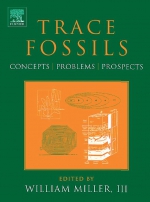Trace fossils. Concepts, problems, prospects
We have been describing and attempting to interpret trace fossils, more or less effectively, for over a century. One could point to several times in the history of paleontology or sedimentary geology when ichnology, as a separate discipline, appears to take shape for the first time. This is largely a matter of when the various early practitioners were active. I will leave it to the historians of our discipline to nail down all the exact dates, key figures and origins of ideas. A concise historical sketch can be found in the introduction to Ekdale et al. (1984). It is clear from this brief account, and from the longer essay by Osgood (1975) and especially the excellent historical chapters that follow, that the origins of ichnology are varied but that the discipline takes on its modern methodologic and conceptual aspects in the 1950s and 1960s. In anglophone countries, this development is usually associated with a ‘founder’ (Dolf Seilacher, signaled especially by a series of extremely influential articles: e.g., 1953, 1962, 1964, 1967a,b) and a ‘founding document’ (Ha¨ntzschel, 1962, 1975)—at least for invertebrate ichnology. Vertebrate and plant trace fossil researchers would tell the story a bit differently (see the essays that follow). But most of the central concepts and methods start to circulate and become widely applied or discussed at about this time.
During the next five decades, the work of ichnology was largely nomenclatural, not simply limited to the naming and revision of ichnotaxa, but involving the classification and naming of ichnofacies, applying and modifying behavioral classification, and involving the documentation of whole assemblages of different ages and depositional contexts—in many instances following Seilacher’s initial concepts. This kind of activity continues to dominate trace fossil research. Growing gradually and less conspicuously along side the nomenclatural approach has been a more analytic perspective. This involves the fundamental business of trying to determine the trace-producing organisms, comparisons with modern trace producers and modern environments, functional interpretations of structures, computer modeling, and novel approaches to the interpretation of paleoethologic, physiologic and physicochemical properties of biogenic structures of all kinds. The one aspect that has never been adequately developed is theory. I am not sure that the nomenclatural systems developed 50 years ago really qualify as biologic theory; this kind of development may have to wait until connections to behavioral ecology and evolutionary theory have been more completely and plausibly established, and is likely to grow more readily from the analytic side of ichnology.
I will be quick to add that the traditional nomenclatural approach has worked very well in getting the modern enterprise of ichnology up and on its feet, has made possible the systematic documentation needed before generalizations could be attempted, and has secured important and reliable applications to sedimentary geology. So, it might be better to say that the biologic side of ichnology is where theory development has lagged—it depends on whether one sees trace fossils primarily as sedimentary structures or as ethologic records. Most modern workers have always considered them to be both, but most have emphasized connections to sedimentology and stratigraphy.
Now, skip forward to the beginning of the twenty-first century, and we see ichnology as one of the most active branches of paleontology (or sedimentary geology, if you prefer), with no signs of slowing down.




